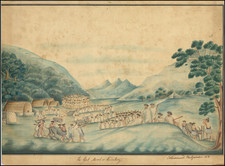Rare Jay Cooke broadsheet promoting the purchase of US Government backed 7-30 bonds, issued during the latter part of the American Civil War.
This large broadsheet, printed on each side with a woodcut eagle with a shield and banner device, was used by financier Jay Cooke to promote the sale of US Government bonds as a means for funding the Union Army during the Civil War. One side features eight columns with 28 patriotic songs including: "[Battle] Hymn of the Republic," "When Johnny Comes Marching Home," "John Brown's Body," "The Star-Spangled Banner," "Yankee Doodle," "America," "Johnny is Gone for a Soldier," as well as "The Black Brigade," "The Yankee Girls," "It is Great for Our Country to Die," and others. On either side are enthusiastic tracts encouraging investors to buy 7-30 Notes or Bonds rather than gold in order to support the war effort. The second side, "Facts and Figures", further promotes the cause. The text is by Samuel Wilkeson.
In the midst of the American Civil War, the U.S. government introduced the 7-30 loan as a pivotal effort to sustain the Union's fiscal needs following the moderately successful 10-40 loan campaign. Unlike its predecessor, which faltered due to reduced interest rates and the absence of financier Jay Cooke, the 7-30 loan represented a strategic adaptation in war financing, marked by its high public engagement and extensive reach across the divided nation.
The 7-30 loan, designed to mature in three years with an interest payment convertible to a long-term bond at 5%, was launched during a crucial period of the war in 1864. Despite initial hesitance from investors accustomed to higher returns, the loan's democratic appeal eventually garnered widespread acceptance, facilitating an unprecedented mobilization of domestic financial resources. This transition was significantly bolstered by the re-engagement of Jay Cooke, whose expertise and innovative marketing strategies revived investor confidence and broadened the bond's accessibility.
Historically, the financing of the Civil War posed a monumental challenge for the Lincoln administration, which grappled with daily operational costs exceeding $2.5 million by mid-1864. The success of the 7-30 loan thus arrived at a critical juncture, enabling the Treasury to meet these expenses while promoting a sense of national unity and investment in the Union cause. President Abraham Lincoln underscored the importance of this financial instrument in his 1864 Annual Address, highlighting its role as a "substantial branch of national, though private, property," effectively owned and owed among the American populace.
Jay Cooke's role in this financial campaign was transformative. Moving beyond traditional methods, Cooke employed an extensive network of agents and innovative tactics such as nighttime offices in major cities, offering free refreshments to attract the working class. These efforts not only democratized investment in government bonds but also integrated the notion of patriotic duty into the financial support of the war effort, thereby enhancing public participation.
Furthermore, the geographic spread of the 7-30 loan sales was notable. Not limited to urban centers like New York and Chicago, these bonds found buyers in remote parts of Maine, Iowa, Wisconsin, California, and even in occupied Confederate territories such as New Orleans and Virginia. This broad distribution helped solidify the Union's financial base at a time when military fortunes were uncertain, and the outcome of the war hung in the balance.
The end of the Civil War did not conclude the saga of the 7-30 loan. With the cessation of hostilities and the assassination of President Lincoln in April 1865, Jay Cooke faced the task of managing post-war debt amidst potential financial upheaval. His stewardship during this transition underpinned the stability of U.S. war bonds, which continued to influence global financial markets well beyond the war's end, showcasing the enduring impact of Civil War debt management on international economic relations.
Rarity
OCLC locates 1 example.












![[Nemesis]](https://storage.googleapis.com/raremaps/img/small/97517.jpg)
![[ Florida Indians ] Ceremonia a Saturioua in expeditionem adversus hostes profecturo, observatae. XI](https://storage.googleapis.com/raremaps/img/small/86474.jpg)
![[Unusual Italian Immigrant Communities shown!] America Settentrionale, Centrale e Meridionale -- Carta Dimostrativa Delle Ambasciate, Legazioni, Consolati (Con Le Risettive Circoscrizioni Territoriali), Camere Di Commercio, Agenzie Commerciali, Stazion Enotecniche, Uffici Postali, Ospedali, Scuole Governative e Sussidiate All'Estero](https://storage.googleapis.com/raremaps/img/small/86098.jpg)
![(Anti-Nato Propaganda) Военные Блоки-Оплот Милитаризма [Military Blocs-Strongholds of Imperialism]](https://storage.googleapis.com/raremaps/img/small/94274.jpg)
![[Florida Indians / Hermaphrodites] Hermaphroditorum officia. XVII.](https://storage.googleapis.com/raremaps/img/small/97966.jpg)